Elevate Customer Experience and Service Operations Center Insight White Paper
Available Languages
Bias-Free Language
The documentation set for this product strives to use bias-free language. For the purposes of this documentation set, bias-free is defined as language that does not imply discrimination based on age, disability, gender, racial identity, ethnic identity, sexual orientation, socioeconomic status, and intersectionality. Exceptions may be present in the documentation due to language that is hardcoded in the user interfaces of the product software, language used based on RFP documentation, or language that is used by a referenced third-party product. Learn more about how Cisco is using Inclusive Language.
Accedian is now a part of Cisco
1. Executive summary
Communications Service Providers (CSPs), spurred by organizational challenges, new technology, and heightened service quality demands, are evolving to make customer experience management an integral part of operations. With 5G and edge computing on the horizon, customers expect guaranteed performance and flawless security, prompting service providers to focus on Quality of Experience (QoE) and satisfaction, a key driver in reducing churn, and developing new revenue.
Growing pressure to deliver an excellent customer experience is pushing CSPs to rethink performance management, transforming networks into automated, self-healing, and self-optimizing systems. An architecture supported by automation, real-time data, and predictive analytics can manage actual QoE in real time, anticipating failures, mitigating risk, and preventing problems before they happen. In essence, CSPs can move past alerts and alarms and, instead, focus on uncovering opportunities to improve services.
This paper examines how innovative Service Operation Centers (SOCs) can support this proactive, customer-first approach while simultaneously adopting new technology and its potential challenges.
After a brief synopsis, we’ll look at the evolution of network management, uncovering why traditional Network Operations Center (NOC) tools and processes fall short, inspiring the rise of the modern SOC. We’ll examine the growing role of Customer Experience Management (CEM) in contributing to the Customer Experience Index (CEI), and how CSPs are using network insights to improve the customer experience.
Next we’ll look at how CSPs are transitioning from the NOC to the SOC, and specific challenges along the way as they move from ensuring smooth network operations to understanding and safeguarding quality experiences.
Finally, we’ll explore how Skylight Sensors and Skylight Performance Analytics augment the modern SOC with network-wide visibility and support for automated service quality management. We’ll learn how Skylight Sensors and Skylight Performance Analytics can help with the CEI analysis process across the network and why they are a good fit for existing SOC deployments, or to help service providers migrate to an SOC—without significant resource cost.
A service-centric SOC is key.
The Service Operations Center (SOC) is the single point of reference for understanding the customer’s view of Quality of Experience (QoE), but an industry blueprint or gold standard for designing the “ideal” SOC architecture is “a work in progress.” Typically, lead vendors implement whatever is readily available from their portfolio, creating varied deployment models and inconsistent success rates. A vendor-agnostic approach to defining SOC architecture is more advantageous as it considers the bigger picture.
While it’s relatively straightforward to specify SOC components and how they relate to each other, it’s more complex to define mechanisms, analytics, data, and how the architecture will work together to calculate a “realistic” Customer Experience Index (CEI). (See page 9 for more discussion.)
One key ingredient is the quality of performance management and analytics data that’s used to create actionable insight related to the customer experience. (See Figure 1.)
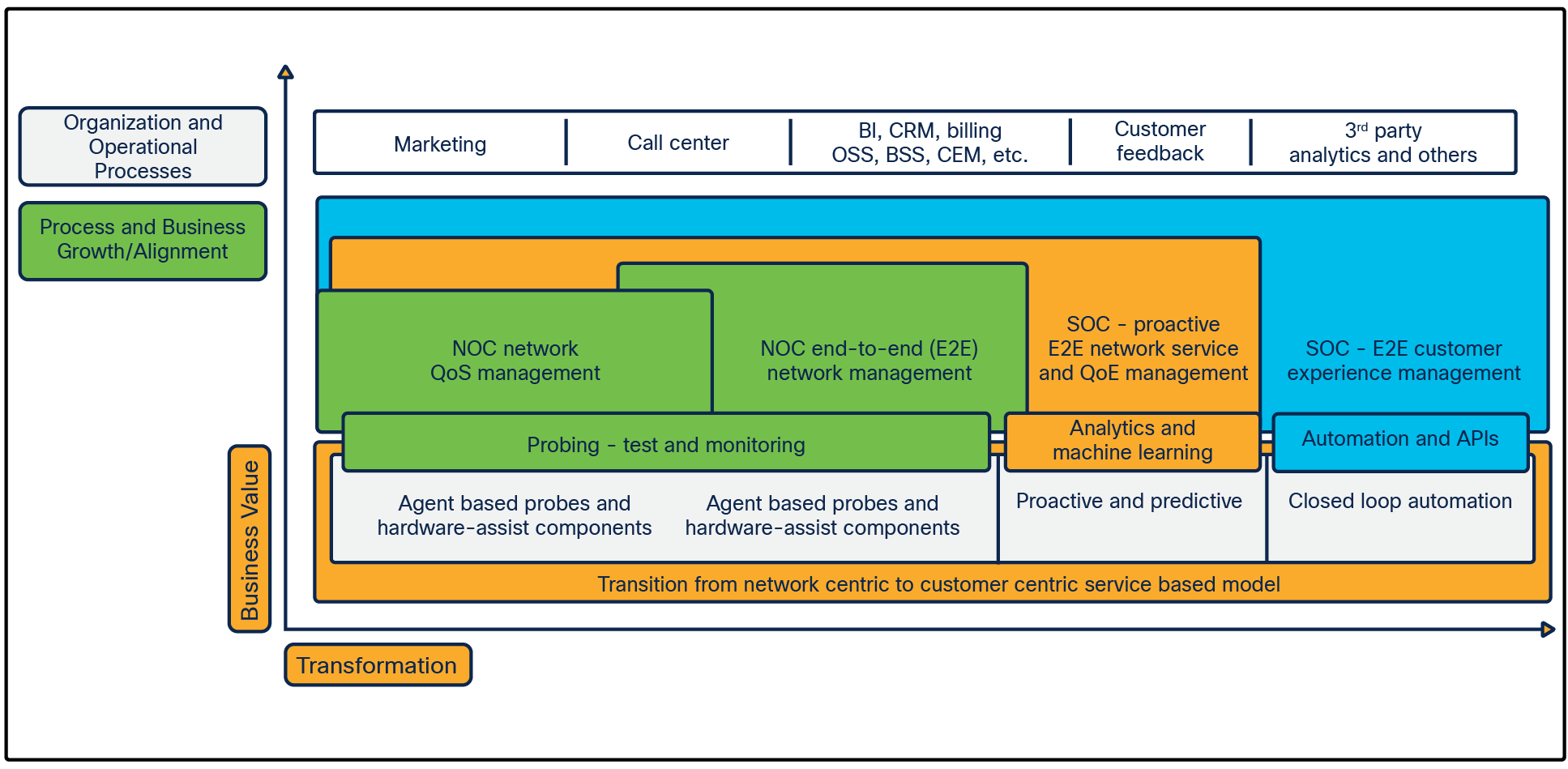
Operational and planning lifecycle operations migrate toward service-based model
Important considerations include Key Performance Indicator (KPI) and Key Quality Indicator (KQI) data, which is indicative of a customer’s “happiness with a particular service.” In addition, network reliability and service layer availability have a significant impact on customer QoE and satisfaction. (See Figure 2.) Both can be determined with accurate performance management data and underlying monitoring techniques.
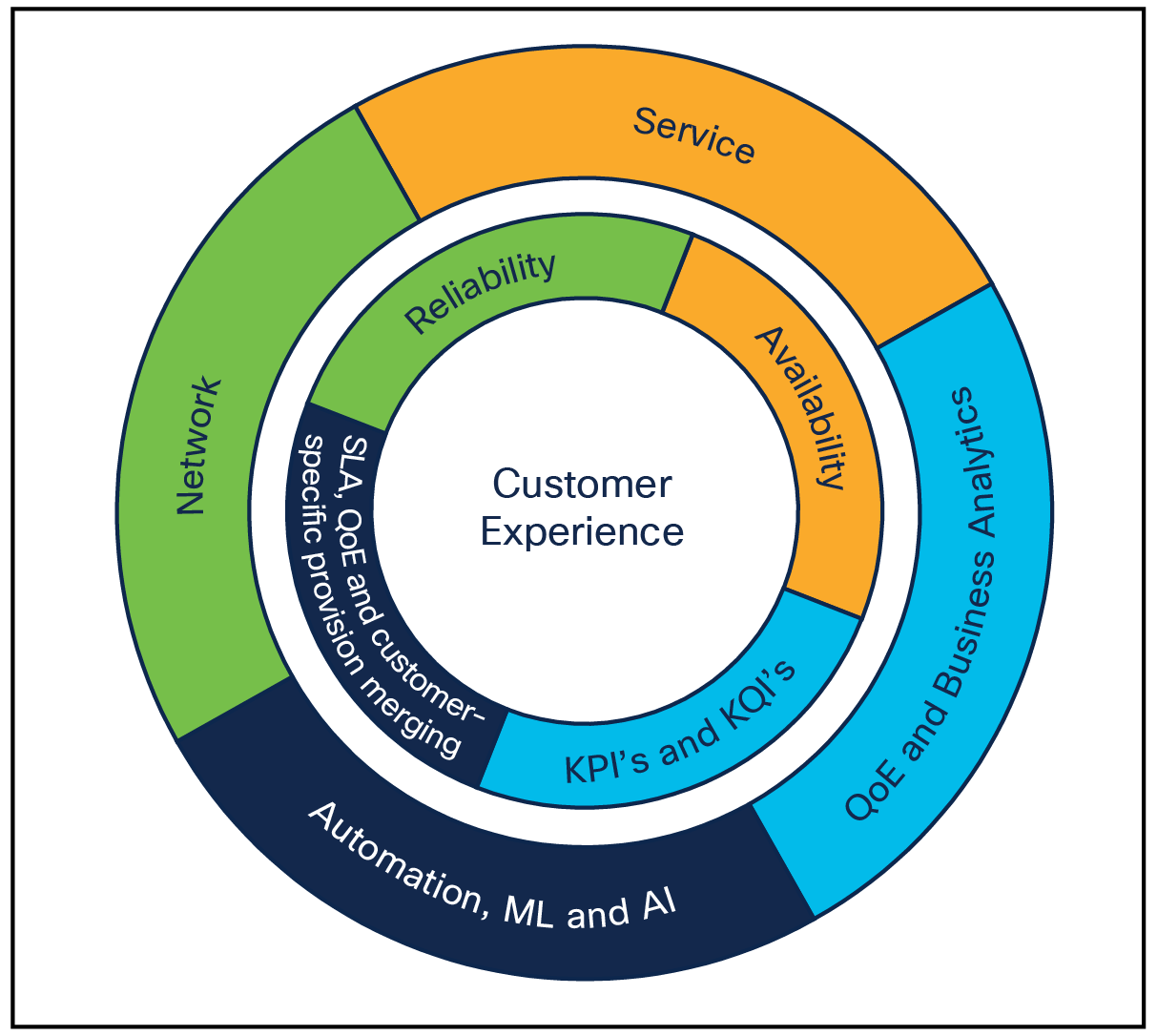
Network reliability and service availability have a significant impact on customer experience
Knowing versus thinking
Thinking customers are happy versus knowing they are is the difference between perceived visibility and the reality of having complete understanding and control of network performance. The goal of the SOC and related performance management systems should be to show what is really going on in the network and service layer on a continuous basis as opposed to only seeing what is going on in the network layer at specific monitoring intervals.
In this way, Skylight Sensors and Skylight Performance Analytics enhance the capabilities of the SOC by providing an accurate view of customer QoE based on high-quality performance data from the network and services layers. Through active monitoring, analytics, and machine learning, timely and accurate KPI and KQI data is fed to actionable systems in Crosswork. In addition, the solution provides visualization and reporting capabilities (based on business rules and APIs) while supporting operator-managed, closed-loop automation.
In sum, the quality of the performance data and insight ingested by the SOC will determine how accurately the real experience of a customer is measured. Even the smallest fluctuation in the network can have a significant impact on the service, perceived network quality, and customer experience.
3. Network management evolution
3.1 Moving from network-centric to customer-centric operations
Over the past ten years, network management systems have evolved to help IT teams operate in more agile ways, incorporating advanced analytics, machine learning, and intelligent automation to continually optimize network performance. However, performance alone is not indicative of superior QoE.
CSPs recognize that reliable, high-quality, consistent services are critical for ensuring a great experience. But it’s the proactive approach—the ability to anticipate and resolve issues preemptively that truly provides a superior experience. Happy customers buy more services and make more recommendations—the key to decreasing churn and unlocking new revenue sources in this competitive space.
With extraordinary customer experience top of mind, traditional Network Operations Center (NOC) processes fall short. Typically, NOC tools are highly network-centric and lack service, customer, and business context. How can operators make informed decisions if they can’t see through the eyes of their customers?
When an issue occurs, operators need visibility into the customer’s service experience to truly know what is happening and why. This level of understanding requires more than simply monitoring resource and network layers, but complete visibility. A top-down approach, starting from the service and then mapping to underlying network infrastructure components, is critical. Only then can you leverage a true proactive approach—detecting, understanding the root cause, and fixing service issues before the customer is impacted.
Network teams today are more focused than ever on Service Quality Management (SQM), which involves implementing the SOC along with new analytics tools capable of measuring and proactively managing service quality. In the modern organization, SOCs bridge the worlds of network operations, commercial teams, and automation capabilities. (See Figure 3.)
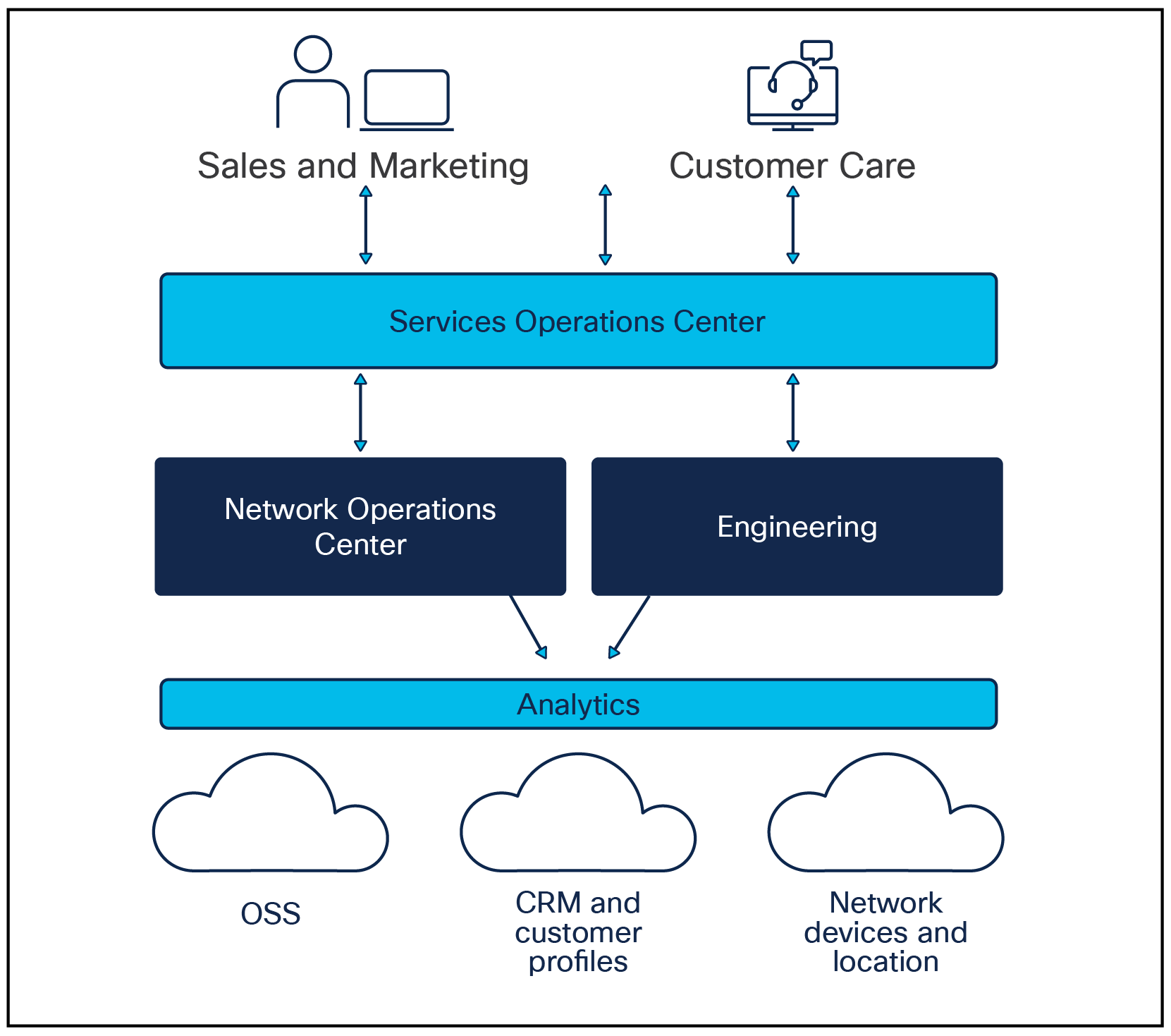
Overview of SOC in organization structure
In the future, SOCs will play an even bigger role in identifying new service and upsell opportunities, proactively engaging customers based on their interests and behaviors. But today, they are focused on monitoring, in real time, all of the service components for each customer.
CSPs can use this insight to prioritize and resolve issues that may impact high-value VIP customers or those at risk of churn. Understanding the end-user experience in this way requires having a single view, in real time, across network segments (edge and core, fixed and mobile), devices and services, applications, and related domains.
3.3 Customer experience management plays a key role
With the shift from network-centric to customer-centric operations under way (see Figure 4), leading CSPs are deploying a Customer Experience Index (CEI) correlated with Net Promoter Score (NPS) to understand the current state of customer experience and satisfaction combined. The CEI is used in SOCs to determine service quality degradations or to understand the types of customers impacted by an outage with insights delivered through both the SOC and Customer Experience Management (CEM) solution.
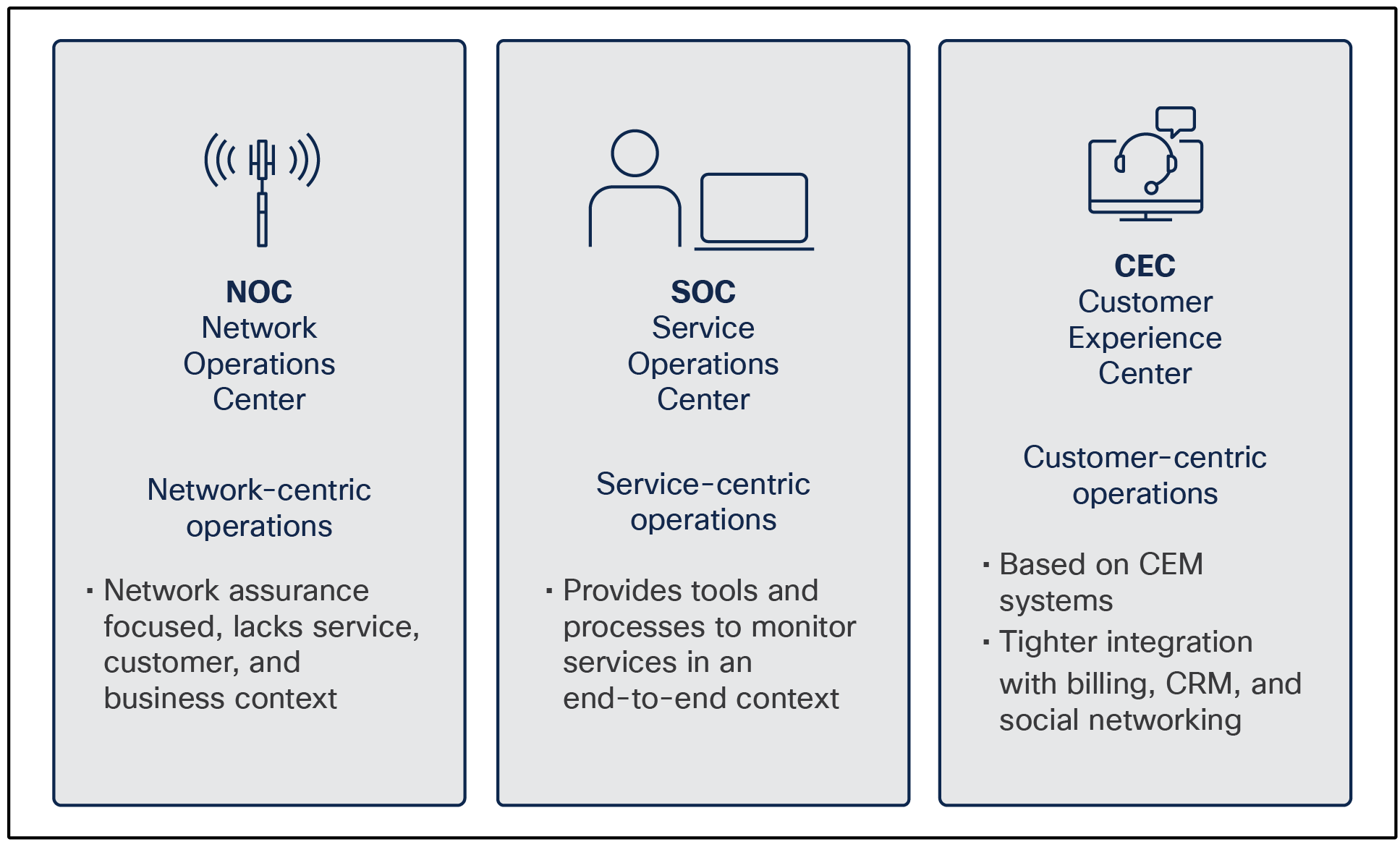
From network-centric to customer-centric operations
Network performance management is based on algorithms that provide high-quality, granular performance data and metrics, correlated, to accurately identify issues that impact the customer experience. What matters most is the quality of the data ingested and how it is analyzed. By considering multiple sources of complementary performance data and analyzing the combined dataset together, it’s possible to yield even greater insights and direct business benefits.
3.4 Reliable network and service data is the foundation of SOC CEM systems
The most important mission of the SOC is to understand how customers truly experience services. But getting an accurate picture depends not only on the quality of data ingested by the SOC, but also the capabilities of its analytics engine.
One key component needed is the ability to collect, ingest, and visualize performance management data from multiple layers of the Open Systems Interconnection (OSI) model. Without this level of detail, the true customer “experience” is missing.
In the past, looking at network metrics alone was enough to resolve many of the issues that customers experienced. Today, the granularity, accuracy, and precision of data—along with the ability to turn it into actionable insight—is critical for success.
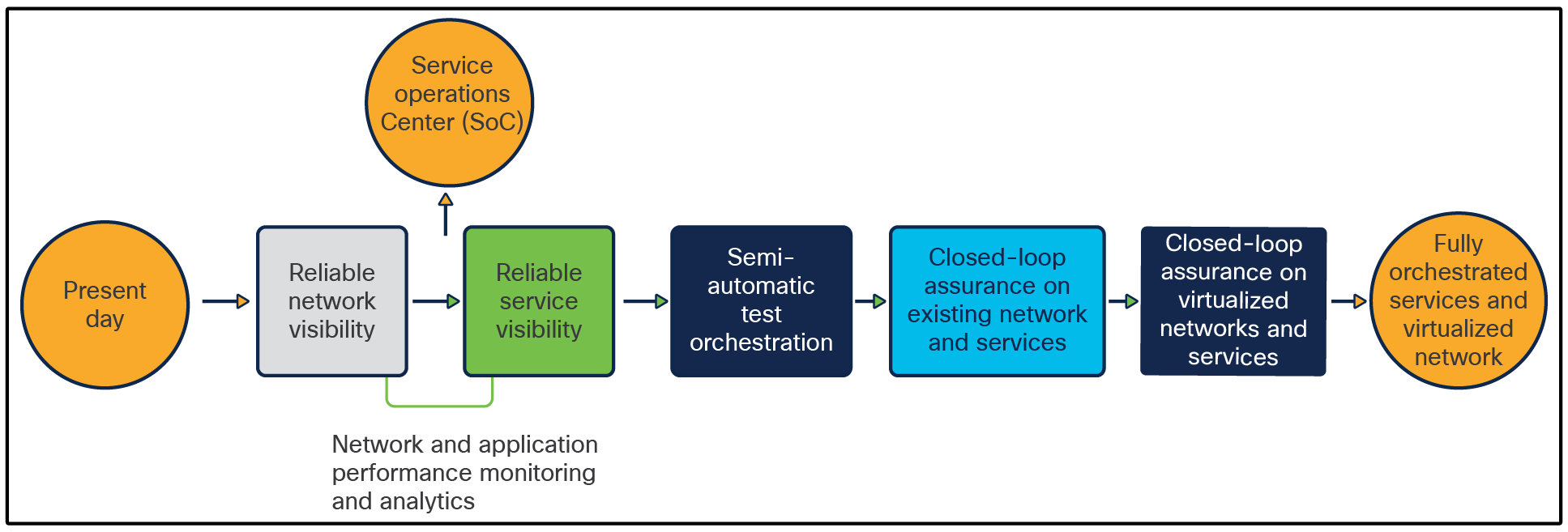
From SOC to automation
A successful SOC uses a single CEI factoring in business, operational, and network processes, with network QoE assigned an appropriate weight. This way, it’s possible to measure the end-to-end journey of the service and how each component impacts the overall customer experience.
In many ways, network and service performance management is more science than art, using algorithms to predict and control service quality proactively—and by proxy, the user experience—rather than compensating for or fixing user experience failures after they have occurred.
Operators prioritize and recognize the importance of network and service quality improvements within their CEM programs. As one European incumbent operator reminds us, “the network better be top-notch and highly reliable, or nothing else matters.”
Using a single CEI to drive network optimization is highly valuable, although many operators find it difficult to provide common visibility and unify efforts across network and service delivery organizations.
3.5 Predictive, real-time analytics are necessary for CEM automation
Automated service quality management is the ultimate goal. Employees sitting behind desks in the SOC who look only at Key Quality Indicators (KQIs) and CEI will not be equipped to manage dynamic, on-demand networks and services in real time.
With Software-Defined programmable Networks (SDN), CSPs realize that operations teams require highly accurate and trusted analytics to control service quality and automate policy on service orchestration. Predictive analytics and machine learning can help identify service anomalies or service-impacting events for proactive management.
3.6 End-to-end service management in real time
Communications Service Providers (CSPs) set up Service Operation Centers (SOCs) to monitor all the services provided to customers in real time, end to end, at the service layer. Using a Customer Experience Index (CEI), correlated with the Net Promoter Score (NPS), operators can manage customer segments (e.g., VIP customers) and assess service degradation by cell site, segmenting groups of impacted customers based on ARPU and how “valuable” they are.
This strategy is changing business processes across network operations, customer care, and planning teams. For example, upgrades can now be planned to improve the quality of experience—not just to meet technical parameters. And calls to customer care teams can be decreased dramatically simply by prioritizing resolutions to network problems that have the greatest impact on customers—a clear OpEx benefit to the CSP.
Customers with a digital self-care app or self-service portal can see for themselves if there is a problem and if a service provider is working on it. And, if a customer needs to call customer care, the CSP is already aware and informed about the specific problem and root cause.
CSPs can also use big data analytics and machine learning to anticipate incidents and identify proactive actions to improve the customer experience and provide excellent network and service performance.
“We are setting up service operating centers where we will monitor, in real time, all the services we provide to customers. Every operator needs this now—with mobile video and voice services becoming more complex. If the network is green, and the customer has a problem, we have problems with current tools. What we need is real-time customer vision, because only monitoring the resource and network layers is not enough.”
CTO of tier 1 European operator
4. Moving to a customer-centric SOC approach
The transition from NOC to SOC changes the focus from ensuring the smooth operation of the network to understanding and safeguarding the quality experienced in key consumer services and by individual high-revenue customers.
The usual stumbling block is the lack of reliable, integrated data. Fundamentally, the SOC can’t function without accurate and up-to-date knowledge of the changing dependencies and state between a customer, their services, and the entire end-to-end network.
This data exists but is often spread out across a multitude of systems, from billing and inventory to management, operations (BSS/OSS), and network systems. Bringing IoT together into a single, coherent, real-time view can prove challenging.
Moving to a customer-centric SOC approach requires a huge collaborative effort—not only concerning the technical architecture, but also from an organizational and cultural standpoint, as new, integrated, organizational process models must be accepted.
4.1 Challenges in SOC transformation
● Cost: implementation, operation, upgrades, data management, storage, and resources
● Organizational change and business processes: what’s needed to support the CEM and SOC model
● Data: what’s collected must be clean, accurate, timely, and meaningful
● Human resources: lack of highly skilled employees (who can make sense of data) with experience in data science, machine learning, and analytics
● Vendor lock-in: addressing this possibility once a particular vendor’s CEM system, including algorithms, is embedded into the SOC
● Key Performance Indicators (KPIs): how will these indicators be collected and how will service quality management be deployed to address the dynamic nature of NFV, SDN, cloud networks, and new digital services
Successful implementation requires answering a variety of questions: “Where can I start this transformation process with minimal impact on cost and how can I start reaping the benefits ASAP? What can I do on day one to make a real difference?” The answers lie in being able to accurately measure and correlate the entire end-to-end service path across the CSP’s infrastructure with high-quality performance management data and insightful analytics.
4.2 Getting the architecture right: The importance of timely, relevant, and accurate KPIs and KQIs
Understanding the challenges is important, but it’s also necessary to understand the type of architecture that’s needed to support:
● The ability to create and manage scheduled/performance-based service segments.
● Multilayer, multislice (5G) management for per-service QoE.
● Continuous monitoring and reporting of service quality and SLA parameters.
● A closed-loop architecture that orchestrates network changes and slices in real time.
● The ability to monitor user behavior and applications.
● Future-proofing for 5G and other customer-centric technologies.
● The ability to correlate all performance metrics—cross-functional and multilayer.
4.3 Context-based service assurance
A context-based assurance and Service Quality Management (SQM) architecture can provide the SOC with:
● Network and service performance visibility.
● Real-time network and service monitoring.
● Real-time application monitoring and analytics.
● Multilayer troubleshooting.
● Dynamic and automated network topology awareness for performance management.
● Cross-domain visibility and correlation.
● Capacity optimization and management.
● Support for automated service delivery.
● Real-time root-cause analysis.
It’s clear that the overall value of a SOC CEM model is based on the visibility and quality of insight that network and service performance management tools provide.
“We believe that we need to have tools that can correlate performance layer by layer; does a problem originate at Layer Zero or further up the stack? We are actively looking into solutions like that. Our main goal is to visualize the service layer and network layers. Our tools now are not correlated; we have to manage network management systems (NMSs) from multiple vendors. If we need to troubleshoot, we have to manually do that. If we could get a more unified common network management layer, that would really help.
We need end-to-end monitoring of our networks (wireless and wireline) to deliver end-to-end SLAs—visibility into all network layers and domains, including transportation, microwave, and other network segments. This is important.”
Tier 1 Asia/Pacific national service provider
5. Skylight Sensors and Skylight Performance Analytics for SOC management
5.1 A fully automated assurance solution
Skylight Sensors and Skylight Performance Analytics enable automated performance assurance and closed-loop automation. Fully integrated with the Crosswork ecosystem, Skylight Sensors and Skylight Performance Analytics help service providers cut through the noise, so they can pinpoint service degradation issues quickly, and automate actions to deliver superior experiences.
How does it work? Skylight Sensors collect raw data, and then stream it back to Skylight Performance Analytics, where it is correlated, analyzed, and made available via a GUI and APIs for real-time visibility into network performance.
Skylight Performance Analytics can also ingest other sources of performance data either directly from the network or via Crosswork Data Gateway to combine and correlate with data from Skylight Sensors to deliver a single-pane-of-glass view of network performance.
The simplified, virtual architecture of Skylight Sensors make deployment quick and transparent for an instant measure of the performance and quality of experience of the end-to-end service. Each component provides the SOC with precise, granular, real-time, and multilayer data that can be correlated with RAN, CRM, and other data as required.
Skylight Performance Analytics acts as the bridge between synthetic active monitoring and the SOC to provide the first level of pre-analytics data processing, visualization, and machine learning capabilities for closed-loop service quality management automation.
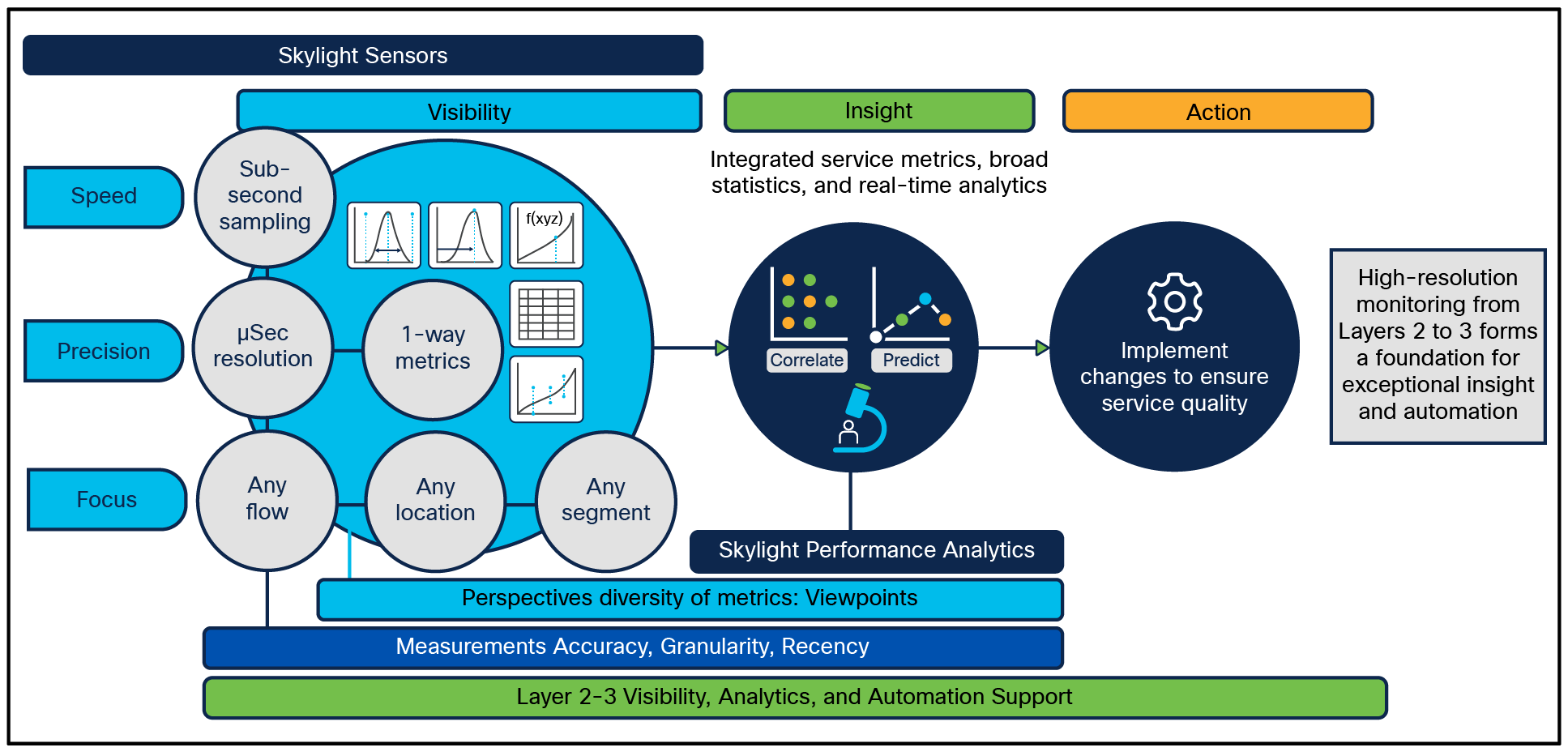
Skylight Sensors and Skylight Performance Analytics in action for enabling automated service assurance
5.2 Improving the SOC with Skylight Sensors and Skylight Performance Analytics
Skylight Sensors provide high-quality granular performance metrics to support the overall architecture of an SOC. It can work with, and integrate into, any SOC, NOC, or CEM architecture—for example, Amdocs, Huawei, Ericsson, or Nokia—that uses standards-based interfaces and protocols for network measurement.
Even without deploying a heavyweight SOC CEM system, Skylight Performance Analytics provides visualization, reporting, and integration capabilities. This helps operators identify key QoE issues by correlating them with the performance management data from Skylight Sensors and third-party systems.
Using Skylight Sensors and Skylight Performance Analytics, CSPs can achieve the following outcomes:
● Reduced operational costs and a more dynamic network through automated deployment of service assurance.
● Improved network quality and agility through proactive monitoring and the ability to troubleshoot performance issues quickly.
The solution’s inherent design works well in an NFV/SDN virtualized environment with or without physical instrumentation—depending on the precision and accuracy of the data required for a particular service segment.
Intent-based assurance for service lifecycle management
To support intent-based assurance, Skylight Sensors and Skylight Performance Analytics have added three main sets of capabilities:
● Describe a service (using an input model) and understand how to instrument the network to provide assurance for the service, automating the placement, deployment, and configuration of the instrumentation provided by Skylight Sensors.
● Understand how a service should behave, creating the KPI metrics relevant to maintaining appropriate QoS (Service-Level Intent [SLO]), track the metrics, detect when the service has an issue, and inform the Crosswork Network Controller to trigger remedial action and optimization.
● APIs for provisioning intent-based assurance (fully integrated with the Crosswork Network Controller) for streaming data and alerts.
With these additions, intent-based assurance becomes part of the service lifecycle. As an autonomous closed-loop system, it adapts to potential service degradation or any potentially user-impacting trends or behavior, driving auto-remediation. This provides direct service quality automation benefits to CSPs on the journey to transform the SOC.
6. Skylight Sensors and Skylight Performance Analytics capabilities
Skylight Sensors provide the following capabilities:
● Test agents (TWAMP/ICMP Echo/UDP Echo/Throughput/Transfer/Trace) and modules provide network and protocol performance management testing and monitoring capabilities.
● The test agent is a virtual (software), standards-based performance-monitoring and test session generator that can be deployed in minutes to enable assurance monitoring at a granularity aligned with the service being delivered.
● Accurate, real-time performance management data is sufficiently “clean” for smart analytics and machine learning.
● The Skylight Sensors flowmeter feature provides a real-time bandwidth utilization measurement that is a useful complement to the active testing and monitoring provided by the test agents.
● Near real-time proactive alerts and processed KPIs to the Crosswork Network Automation layer to drive actions in a closed loop.
● Complements network and service performance monitoring with real-time feedback to validate the user experience after automation changes have been executed.
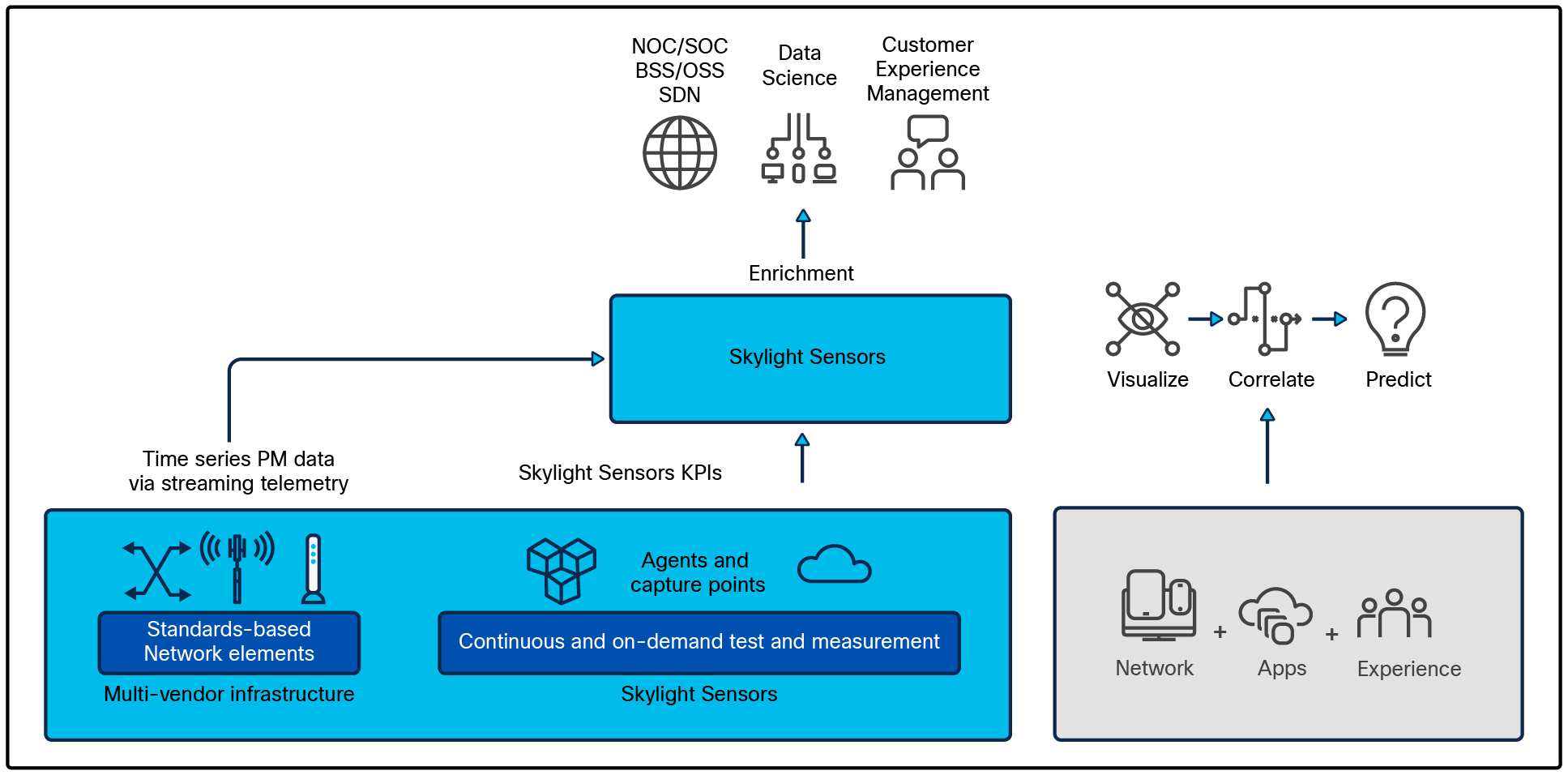
Skylight Sensors and Skylight Performance Analytics: how it works
A fully integrated solution. Skylight Sensors and Skylight Performance Analytics is a fully integrated, easy-to-implement solution for active testing, monitoring and machine learning–based analytics and insight. Typically, this would require integration work and interoperability between different systems and a mediation layer to access data from existing tools and systems.
Currently, most SOC models are based on vendor-specific solutions. To achieve a timely and successful deployment, operators must select a vendor that can integrate the full architecture spectrum—including building, possible operation, and management of the entire process to move from NOC to SOC.
Significant cost savings. On average, a comprehensive SOC architecture once deployed can reduce OpEx up to 20%. However, the initial CapEx required is high compared to Cisco’s approach.
Easy to deploy. Heavyweight SOC CEM systems typically have a large footprint and require significant hardware deployment throughout the network to collect and analyze data. Skylight Sensors and Performance Analytics can complement and/or replace components of the SOC in the service and network performance areas depending on the requirements of the overall architecture.
Communications Service Provider (CSP) networks are key enablers of digital service delivery. To stay relevant and continue to grow, they need to be proactive in providing the high-quality services their customers expect. To stay competitive, CSPs must transform. This means updating and revising outdated, legacy processes and building new systems to measure and understand the quality of service that customers experience in real time. The goal is to move from reacting to network issues to predicting them before they happen, avoiding subscriber impact by taking proactive action.
Skylight Sensors and Skylight Performance Analytics fit into the SOC model based on the ability to provide high-quality, reliable performance management data where it is needed in a timely and lightweight fashion.
To learn more about differentiating your services with exceptional customer experience, or to schedule a demonstration of Skylight Sensors and Skylight Performance Analytics, contact your Cisco sales representative. For more information on Cisco’s network automation portfolio for service providers, please visit www.cisco.com/go/crosswork.